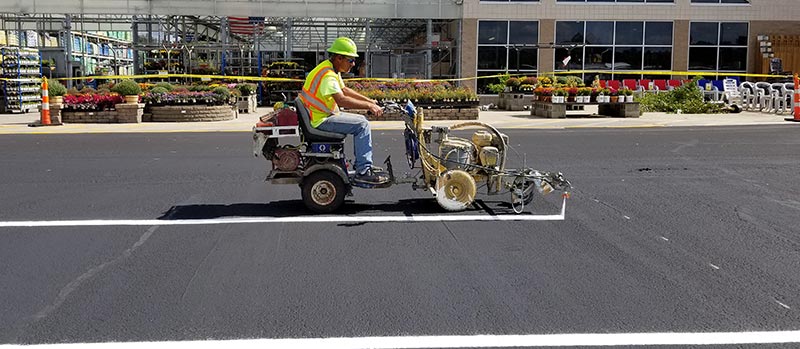Fascination About A1 Professional Asphalt & Sealing Llc
Table of ContentsThe Facts About A1 Professional Asphalt & Sealing Llc UncoveredA1 Professional Asphalt & Sealing Llc Things To Know Before You Get ThisLittle Known Questions About A1 Professional Asphalt & Sealing Llc.4 Easy Facts About A1 Professional Asphalt & Sealing Llc DescribedSome Ideas on A1 Professional Asphalt & Sealing Llc You Need To Know

The oil in a vehicle engine is not just oil. It consists of a range of additives to boost the lorry's performance. These consist of polymers, thickness modifiers, warm stabilizers, extra lubes, and put on ingredients. The REOB contains all the ingredients that remained in the waste oil along with the wear metals from the engine (generally iron and copper).
Nevertheless, by making numerous blends utilizing various REOB samples and different asphalt binders, the variations mostly can be averaged out. Numerous States gave samples of recognized REOB structure to TFHRC scientists, who evaluated the samples to contrast the percent of included (known) REOB to the found (checked) amount. The evaluations revealed a comparable percent of added and located REOB.
Some Known Details About A1 Professional Asphalt & Sealing Llc
They received an overwhelming response. The TFHRC scientists examined 1,532 samples from 40 States, one Canadian district, and 2 Government Lands Highway divisions. They assessed each sample twiceamounting to more than 3,000 evaluations. None of those States recognized that the asphalt they were buying had REOB. One State insisted its examples had no REOB.
Of the 1,532 examples evaluated, 12 percent contained REOB, and some contained appreciably high degrees of it at 1020 percent. The highest degree was 34 percent in an example from Texas, which TxDOT had used in a patching substance. This screening also disclosed the presence of phosphoric acid in 11 percent of the examples, and 2 percent consisted of ground tire rubber.
2 years back at TRB's annual meeting, the Federal researchers held an REOB workshop and offered the searchings for of their lab evaluations to a standing room-only crowd. Some companies do not specifically prohibit REOB, they do enforce physical tests that prevent its useeffectively a restriction. Others do not ban it by requirements, however have arrangements with asphalt distributors to prevent the use of REOB
A1 Professional Asphalt & Sealing Llc for Beginners
A handful do permit REOB, some within certain limitations. As an example, Ohio and Texas restriction degrees to less than 5 percent of the asphalt. To create a trustworthy examination technique that all States can use, the TFHRC researchers established a round-robin test plan. The participants are 11 State highway firms (Illinois, Massachusetts, Minnesota, Mississippi, Montana, North Carolina, Oklahoma, South Carolina, Texas, Vermont, and Wyoming), 2 independent screening laboratories, the Ministry of Transport in Ontario, Queen's College in Ontario, and an Ontario paving service provider.
In total, the scientists prepared and shipped 720 blends. The participants are examining the samples independently using the guidelines provided by the TFHRC scientists. The round-robin screening is almost completed, and TFHRC is in the process of accumulating the results. The output will be a recommended AASHTO examination technique that any type of State can take on and make use of (a1 professional).
The sidewalk with REOB, which is situated 0.6 mile (1 kilometer) from the pavement without REOB, has similar subgrade, traffic thickness, and climate. The sector of Highway655 with 5 to 10 percent REOB revealed considerable cracking. In this instance, the presence of REOB was the recognized source of fracturing at a low temperature levels.
"In our experience in copyright, also little amounts of 23 percent can be a problem." In a similar way, a section of examination sidewalk in Minnesota (MN1-4) found to have REOB likewise fractured prematurely. The sidewalk performed well for the very first 3 to 4 years, yet then started to fracture. This sidewalk is also subject to reduced temperatures.
Not known Facts About A1 Professional Asphalt & Sealing Llc
The examinations were not considerable, yet they revealed that at degrees of 6 percent or more, the tensile strength of the asphalt dropped considerably. At a level of 3.5 percent REOB, the variant in the physical examination approaches was higher than the impact of REOB. It was difficult for scientists to examine whether REOB was existing. https://triberr.com/a1asphaltseal.

One binder criterion thought about is the difference in between the low temperature critical requirements temperature for rigidity (S) in the flexing beam of light rheometer and the bending light beam rheometer creep slope (m-value) kept in mind as Tcritical. 2 independent study groups, one from AASHTO and the other from the Asphalt Institute, ended that even more research is needed on the use of REOB in asphalt.
Previously, all asphalt screening measured engineering buildings such as rigidity. These tests do disappoint what products had been included in the asphalt. One example gotten throughout the TFHRC research study had a very odd analysis. The example had the following examination outcomes: Superpave PG 64-28 with a heat quality of 67.3 Tcritical on the bending light beam rheometer was 6.7 degrees Celsius.

Facts About A1 Professional Asphalt & Sealing Llc Revealed
These outcomes show there are weak points in the standardized engineering screening protocols that might be made use of. The producer may have an economic advantage and the item passes all the standardized tests, yet the item might not be valuable to making certain lasting performance. To address this concern and the development of new asphalt additives and extenders, TFHRC is beginning a research study program to utilize handheld spectroscopic tools, x-ray fluorescence spectroscopy, and Fourier transform infrared spectroscopy to enable evaluations to be performed in the field instead than having to take samples back to the laboratory.